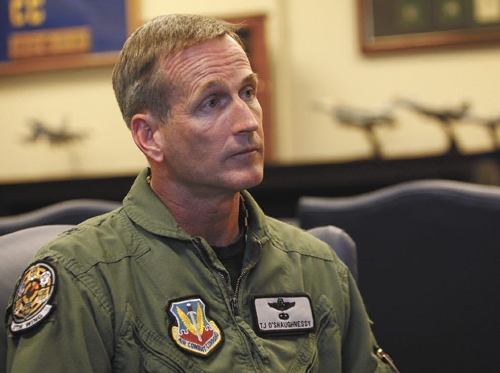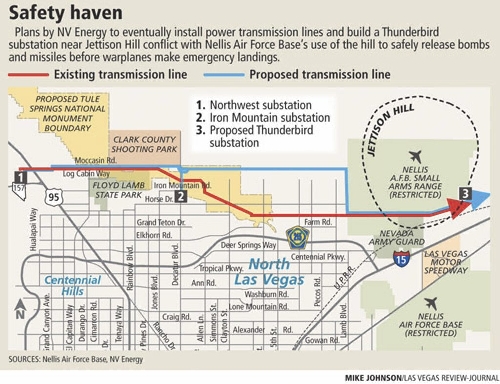Air Force joins power struggle over Jettison Hill




The bald mound looks like a void in the Mojave Desert to motorists speeding northeast on Interstate 15 toward Utah.
But Brig. Gen. Terrence O’Shaughnessy, commander of the 57th Wing at Nellis Air Force Base, sees a safety net protecting Las Vegas from a catastrophe.
The empty space on the map is known as Jettison Hill, a safe place for pilots to "punch off" bombs and missiles when they are forced to make emergency landings.
"We like Jettison Hill because it gives us a margin of safety," the general said, sitting in his office while jets thundered overhead. "Safety is paramount for our operations here at Nellis. And when we say safety, we just don’t mean the air crews and those flying the airplanes. We mean safety to include all folks living in the surrounding area."
The future of the safety net has become snarled in an energy company’s push to put power transmission lines across the northern Las Vegas Valley and build a substation not far from Jettison Hill.
If it is built, the pilots who fly to the 12,000-square-mile training range north of the base would be faced with obstacles and uncertainty in the rare event that they would have to suddenly release their bombs and missiles. That could interfere with the base’s mission to train fighter pilots from all service branches and coalition forces.
NV Energy plans call for power lines on towers 125-feet to 150-feet-tall, and workers out there maintaining the grid. That worries the general.
"That would take away much of the benefit of having such a Jettison Hill-type location where we know with some certainty there’s nobody we’re going to hurt when we jettison our bombs and missiles," O’Shaughnessy said.
NV Energy’s power line plans resurfaced during meetings to discuss a proposed fossil beds national monument.
For decades, scientists have known the Upper Las Vegas Wash holds hundreds, if not thousands, of fossilized remains of Columbian mammoths and other ice age mammals in sediments dating from 7,000 to more than 200,000 years.
Some of the fossils were uncovered when the energy company’s predecessor installed power lines years ago along Moccasin Road.
NV ENERGY PERSISTS
The Public Utilities Commission last year rejected NV Energy’s plan to spend $12.5 million for studies, permits and rights-of-way for a second transmission corridor and a substation in the area.
The commission said the proposal would be risking taxpayer dollars because of complications from Nellis, the Paiute reservation and various conservation areas, including the proposed fossil beds monument.
But NV Energy officials have persisted with their proposal.
Power company officials declined to attend a March 24 meeting about the fossil beds monument, instead sending an email.
"NV Energy has consistently proposed a route along Moccasin that allows us to reliably meet the needs of our customers while simultaneously minimizing the impacts to the community and valuable paleo resources within the proposed National Monument," wrote Edgar Patino, the company’s local government affairs manager.
The email didn’t elaborate on what would be done to minimize the impacts, nor did it address safety concerns raised by Nellis officials.
Four days after the meeting, NV Energy President Michael W. Yackira, Las Vegas Mayor Oscar Goodman and North Las Vegas Mayor Shari Buck signed a letter to Sen. Harry Reid, D-Nev., and the rest of Nevada’s congressional delegation, saying they supported a bill to create the national monument and that it "should accommodate a transmission/utilities corridor."
Besides "attracting national and international visitors" interested in scientific, cultural and natural resources, the letter said the legislation would result in "orderly urban development of adjacent lands" and "necessary infrastructure to service existing developed areas and future development."
In a telephone interview Wednesday, Patino gave three reasons why the company continues to pursue a Moccasin transmission corridor: reliability of the system in general, future expansion in the northern part of the Las Vegas Valley, and "to facilitate delivery of renewable energy into our system."
Patino acknowledged the plans include a proposed Thunderbird substation near Jettison Hill. The "conceptual route does go along the southern portion of what’s called the Nellis Air Force Base small arms range," he said.
The company foresees using these lines to deliver electricity from solar farms in the Amargosa Valley.
Another company, Valley Electric Association, intends to build a transmission line in the southern Las Vegas Valley, far from Nellis flight operations, to reach Eldorado Valley south of Boulder City. Several companies have proposed solar farms in and around the Amargosa Valley, and reportedly are looking to sell power to California instead of NV Energy.
Patino said the most economical and viable route to serve NV Energy customers is the proposed Mocassin corridor. Any other route "would not accomplish the three specific things I told you about," he said. "There is no benefit to our system or our customers."
Regardless of NV Energy’s desire for expansion in the northern Las Vegas Valley, the Air Force and another stakeholder, the National Parks Conservation Association, aren’t swayed.
NO ‘CHEESY AMUSEMENT PARK’
Lynn Davis, Nevada field office manager for the National Parks Conservation Association, said the proposed national monument is supposed to be "a special place that is expected to be visited and enjoyed by Americans and international visitors for generations to come."
"We’re not creating a cheesy amusement park called ElectricLand. But somehow NV Energy has hijacked the dialogue to be all about them," Davis said.
She said "no one is throwing a parade for NV Energy’s request, a corridor that has yet to be proven needed, that jeopardizes all this national monument can be, and that saddles ratepayers with higher power bills."
Because of the nature of an in-flight emergency, Jettison Hill needs to have a sizeable buffer zone, unobstructed by power lines, O’Shaughnessy said.
"This is not a delivery like you might see on CNN, where we’re doing a very precise delivery and hitting a coordinate in exactly that location," he said.
"Remember this is an emergency situation, a time when an aircraft is having a problem. So we need an area, not just a single point of impact on the ground, to give that air crew the ability to have that margin of safety."
While it doesn’t happen very often, a pilot had to use Jettison Hill two months before O’Shaughnessy’s interview.
On Feb. 11, the pilot of an A-10 Thunderbolt II attack jet purposely dropped a pair of 500-pound bombs on Jettison Hill in order to make a safe landing at the base after having experienced an engine problem shortly after take-off. The explosions from the Mark-82 general purpose bombs were so powerful that workers at Las Vegas Motor Speedway felt the percussion shake the building they were in.
Before that, the last time a pilot needed to use Jettison Hill was Sept. 19, 2008, when an A-10 was forced to return to the base because of a fuel imbalance. At 1 a.m. the hill was hit with a 500-pound bomb. The pilot also released pods for rockets and illumination flares.
"So, this is not something that happens on a regular basis; but when it does happen, the events can be catastrophic if we don’t have a good plan in place. That’s why we like having the option of Jettison Hill available to us," O’Shaughnessy said.
No other hill could serve as a safety net. The proximity of runways at Nellis and departure routes makes Jettison Hill "ideally suited" for the task. Without it, "we would put the local community at risk, we would put our pilots at risk and ultimately compromise safety," he said.
Virtually every day, planes fly out of Nellis carrying live munitions. With nearly 47,000 sorties last year, it is one of the busiest airports in the nation. Despite the volume of aircraft traffic, the base has "a fairly pristine safety record," O’Shaughnessy noted.
"The reason we’re able to do that is because we take safety seriously. It’s part of every mission briefing. It’s part of every mission debriefing whether it’s crews locally or our partners from the Navy and the Marines and our foreign coalition partners."
Contact reporter Keith Rogers at krogers@reviewjournal.com or 702-383-0308.












